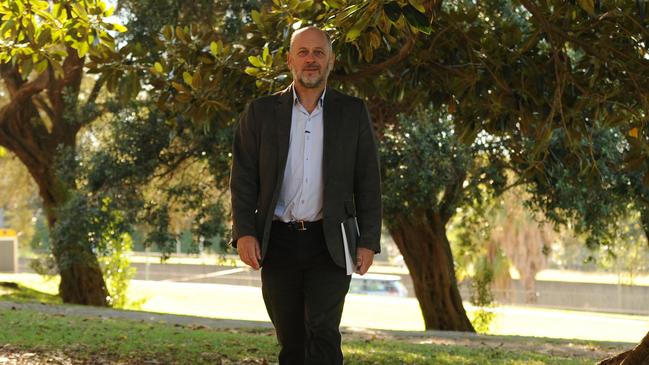Climate activist Tim Flannery holds court with investors

Professor Flannery, chief counsellor to the Climate Change Coalition, says the question that will decide Australia’s future of prosperity is whether we export electrons or molecules – solar energy along subsea cables as championed by Mike Cannon-Brookes or hydrogen. He favours electrons.
And he says if Australia gets a fourth La Nina, it could be enough to tip it back to the Pliocene Age where vast tracts were covered in equatorial forest.
Moon shots for energy transition are sand batteries and borates, rocks that eat CO2 when crushed.
Professor Flannery says humanity has released between a quarter and a third of the greenhouse gases that we have ever released since 2009. And he sees near term zero emissions targets for companies and countries as vitally important: “They are the ones you can act on, the 2030 targets.”
As to the integrity of 2030 targets sitting in company annual reports Professor Flannery is blunt. “I don’t believe anything,” he says. “I’m a scientist. I know we can’t prove anything. Come 2030 we can falsify things. We will see.”
A palaeontologist by training, Professor Flannery’s books The Future Eaters and The Weather Makers (written ahead of An Inconvenient Truth) are in many an Australian bookcase.
At one stage, Professor Flannery was seen as a modern Club of Rome member but in the last decade the dial has shifted dramatically in favour of his arguments on the urgency of energy transition.
He says whether the tipping point has been reached at which business sees more opportunity than risk in climate change depends very much on the business.
“The scale of the change is going to be very challenging. I suspect a number of businesses have not understood how quick the change has to be,” he says.
Professor Flannery says Cannon-Brookes’ Sun Cable – which plans to export solar power to Singapore – will be game changing, if that is, the costs can be pulled down. He compares it to the equally ambitious idea at the end of the 19th century to lay subsea telecommunications cables.
On hydrogen, the questions might be trickier. “Can we cost effectively reduce it? Can we ship it in the form of ammonia or compressed hydrogen? We don’t know yet,” he says. “One of those, maybe both will happen.”
Personally, Professor Flannery bets are on the solar option.
“It just seems to me that electrons are easier to transmit inherently than molecules – a first principles is on my part,” he says.
His moon shots, most at the venture capital stage will be new news to many investors. The first is a sand battery that can hold temperatures up to 800-900C and store it for weeks at a time.
Professor Flannery has seen it operating in Sicily. “The Italian one is a marvellous thing. It has 400 tonnes of sand in it, and it can sit there for weeks or months until they need the energy. It is a 6MW battery,” he says.
Professor Flannery came across borates, as a judge on Richard Branson’s 2015 Virgin Earth Challenge. Of 10,000 ideas he says it was one of only three or four that added up to a scalability.
“In Australia we have a lot of silicon rocks and we know how to mine. If you grind up a kilogram of it, it can sequester 1.5 kilogram of CO2. My suspicion is that come the 2030s anyone who’s got access to a technology or a pathway that allows us to pull CO2 out the atmosphere at scale will really have money in the bank,” he says.
The climate warrior welcomes the government’s first move on its Wiring the Nation policy in an announcement with Victoria to fund the Marinus cable from Tasmania and the interconnector from Victoria to NSW. “The federal government had promised $20bn for interconnectors” says Professor Flannery. “Some of those big interconnector projects are 12 to 18 months behind, so that means that the system will be slower making the transition.”
The passing of the Inflation Reduction Act in the US, really a greenflation reduction act offering incentives for green investment, has raised concerns that capital will be lured away from Australia.
“As a scientist I’m not worried because it is a global problem, so it does not matter where the emissions re reduced. But from a patriotic perspective I am concerned,” says Professor Flannery.
That said, he believes that with great natural advantage in Australia he cannot imagine the country not attracting capital.







When a house like Credit Suisse brings in Tim Flannery to headline a conference for top clients, it is clear markets want to know much more than they do about the risks and the upside of climate change.